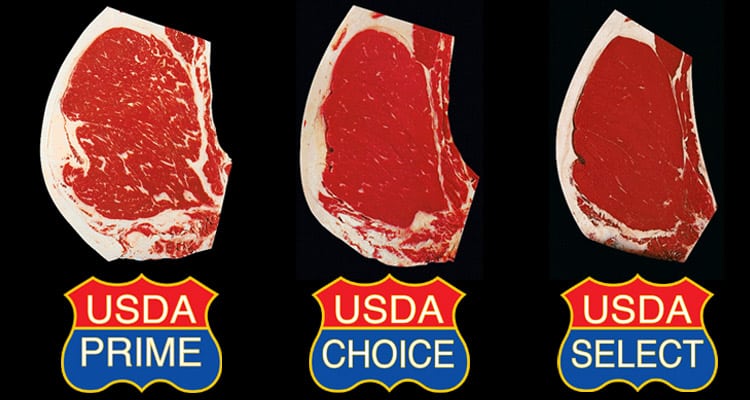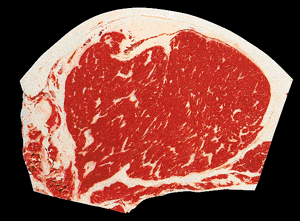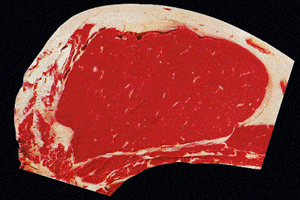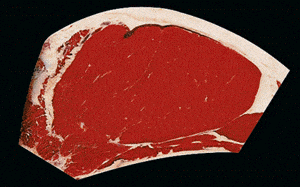Ever wonder what the difference is between a Prime cut and a Choice cut of meat? Which one is better? How about a Select cut? Who determines the grade of beef and what are the primary considerations that factor into it?
How does the grade of meat you have selected affect the taste, tenderness, and cost of your dishes? Are there factors beyond grading that are important to consider?
In this article, I’ll fill you in on the USDA’s grading system, and arm you with the information you need to select the perfect steak.
Table of Contents
The Purpose and History of USDA Grading
The USDA grading system is a voluntary system paid for by the beef industry. Through this program, inspectors of the US Department of Agriculture assign a grade to each beef carcass during processing to help ensure uniform quality in the sales and marketing of beef. This is in recognition that not every cow that rolls off the line is created equal, and the prices should reflect this fact.
The program itself dates back to the early 1920′s when an organized effort was underway within the livestock and retail meat industry to establish a beef grading and stamping service by the Federal Government for all federally inspected plants that would make the benefits of such a service available to all consumers.
As a result, in 1926 the Secretary of Agriculture promulgated the beef grade standards as the official U.S. Standards for Market Classes and Grades of Carcass Beef, and by 1927 a one-year, national experimental program of Federal grading of beef carcasses was underway.
How beef is graded
Grades are based on the amount of marbling in the meat and the age of the animal.
Marbling is the flecks and streaks of white fat you find distributed throughout the meat. In general, the higher the degree of marbling, the more tender, juicy, and flavorable the meat will be.
Consequently, higher-grade meats come at a higher cost. Age also plays an important part. Beef is best in flavor and texture when cattle are between 18 and 24 months old, so the grading favors younger animals.
What are the grades of beef?
There are eight distinct grades of beef recognized by the USDA. In order of descending quality they are:
- Prime
- Choice
- Select
- Standard
- Commercial
- Utility
- Cutter
- Canner
Studies suggest that beef graded at least USDA Select are likely to be acceptable in eating quality for most consumers, so this is usually the lowest grade you’ll ever hear mentioned by name in the supermarket. Mmm! 100% UTILITY GRADE BEEF!
Unlabeled cuts of meat are either commercial or utility-grade, or more likely were never graded in the first place.
The lowest grades, cutter, and canner are used in disgusting things like potted meat and those meat sticks you find in the gas station. Let’s look a little closer at the three primary grades of meat you’ll likely be selecting from.
USDA Prime beef
This is the grade of beef that contains the greatest degree of marbling. It is generally sold to finer restaurants and to some selected meat markets. It is significantly higher in price because less than 3% of the beef graded is Prime.
Prime grade beef is the ultimate in tenderness, juiciness, and flavor. Prime Rib is a USDA Prime rib roast for example, and many top steakhouses serve only Prime cuts.
Here’s an example of a Prime cut with heavy marbling.
USDA Choice beef
Choice grade beef has less marbling than Prime but is still of very high quality. This is the most popular grade of beef because it contains sufficient marbling for taste and tenderness while costing less than Prime. Just over half of the beef graded each your earns a grade of Choice. Choice cuts are still tender and juicy.
Here’s an example of a Choice cut.
USDA Select beef
This is generally a lower-priced grade of beef with less marbling than Choice.
Select cuts of beef may vary in tenderness and juiciness. Select has the least amount of marbling, making it leaner than, but often not as tender, juicy, and flavorful as the other two top grades.
About a third of beef graded falls into this category. Here’s a sample.
Selecting the perfect steak using the USDA Beef Grading System
If cost were no object, we’d all feast on Prime beef. Reality being what it is we must weigh our options. Most markets today offer a selection of Choice and Select cuts, while a few high-end stores will offer a selection of Prime as well. If your supermarket doesn’t carry Prime beef, you may have better luck at a local meat market.
Choice grade cuts are a good compromise in terms of cost and taste, but if you are planning on marinating your meat, you can save some money by purchasing one of the cheaper grades. The marinade will help soften an otherwise tougher cut.
When selecting an individual piece of meat, look for a cut that doesn’t have an excessive amount of outer fat, but with a good, even marbling. The fat should not be yellowed or gray, but creamy and moist looking. The color of the meat itself should be rosy, cherry red, and evenly hued. It should be firm to the touch and have a fine texture.
Ideally, you can obtain Prime beef that has been aged from four to six weeks. Aged beef has more flavor, so you’ll want to avoid beef that is “too fresh”. Aging however is a controlled process, so it’s not the same as beef that’s been setting in the cooler for a month.
Don’t be afraid to ask the butcher about the source and quality of their beef.
Related content you might like:
- 11 Best Built-In Gas Grills for 2024
- 10 Best Natural Gas Grills for 2024
- 10 Best Wireless Meat Thermometers for 2024
- 15 Best Stainless Steel Gas Grills for 2024
- 10 Best Gas Grills Under $1000 for 2024
- 5 Best Outdoor Grill Prep Tables for 2024
- 10 Best Steak Knives Set Reviews for 2024




